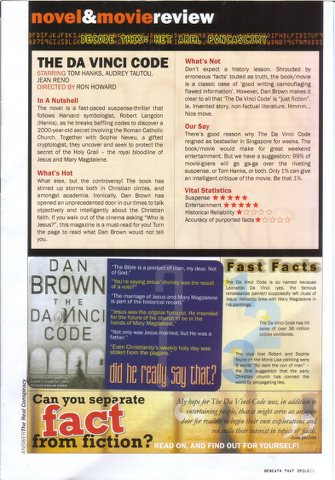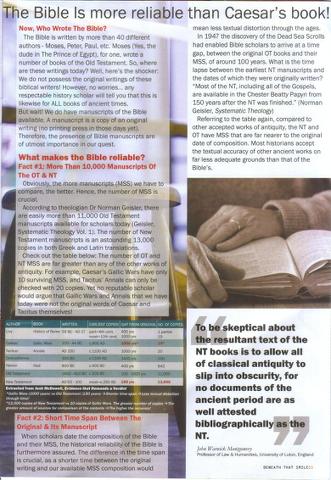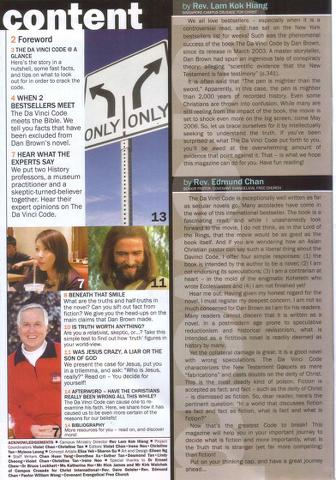Addendum: Part 2, Part 3. I have also re-uploaded the images to imageshack since the original versions were lost when their server went down years ago
My ever-resourceful and hardworking Little Bird scanned in the contents of a CCC (Campus Crusade for Christ) pamphlet targetted at Dan Brown's "The Da Vinci Code" for me, zipped into an appropriately titled "BibleTrash.zip".
Now, I am no fan of Dan Brown, since his allegedly well-researched book is full of rubbish. As I often say, there is only one true line in "The Da Vinci Code" ("The Bible did not come by fax from heaven"). Yet, 2 wrongs do not make a right, and this pamphlet is annoying. And so I present what is probably an exclusive feature: not only scans of the pamphlet but a walkthrough the specious arguments contained inside.

Cover - "A companion guide to the movie or novel!"
The cover of the pamphlet looks innocent enough. It is glitzy and official-looking, complete with the barcode at the bottom left hand corner of the magazine. In fact, one would be led to believe that it is an official piece of "Da Vinci Code" merchandise; I believe the customary practise is to say that you are writing a "totally unauthorised guide" - Dan Brown should sue the CCC for copyright infringement. The Mona Lisa's enigmatic smile hardly prepares one for the horrors inside, yet a hint of it can be found in the promise of an interview with a skeptic-turned-believer (no word about believers-turned-skeptics).
As is the case with much evangelical-fundamentalist material, the cover of the pamphlet is innocent, only truly revealing its contents when one flips it open - a pamphlet they gave out about the Tsunami was similiarly deceptive, and IIRC contained numerous back-handed insults to the memory of Tsunami victims.
When one opens the pamphlet, one's baloney detectors start to go off. Looking at the content area on the right, one sees 2 forewords written by Reverends from Christian groups, purporting to present information to help readers realise "the Truth". Now that in itself is not sufficient to disqualify the pamphlet, but it is an important clue - one wouldn't expect a publication of the Flat Earth Society to conclude that the earth is round. Further, since the pamphlet promises not to toss logic out of the window, we can turn on our scrutiny-lamps to full power.
One also sees that the good ole "Lord, Liar, Lunatic" false trilemma makes an appearance. Really, you'd think that 35 years after CS Lewis's Mere Bullshit Christianity, they'd get their logical fallacies sorted out.

Page 2 - "novel & movie review"
No comments, other than the very suspicious rating system - giving the movie an eye-boggling 5/5 stars for "Suspense" and "Entertainment", but 1/5 for "Historical Reliability" and "Accuracy of purported facts". Given that the movie is slated for a May 19th release, one wonders what privileges fundamentalist Christians are privy to that ordinary mortals aren't. There is also a curious complexity worthy of a close reading: as the "movie" review itself reads, "Dan Brown makes it clear to all that 'The Da Vinci Code' is "just fiction"." If this is the case, the "purported facts" would not have to be graded - I'm guessing that they mean that Dan Brown admits that his story is made-up, but his so-called facts are false. This smacks of shoddy writing.
This page comments that the Da Vinci Code and Bible both "purport to tell the truth about the life of the historical Jesus (we just can't escape his influence, can we?)". The little comment at the end irks me, so I'll just add that we can't escape the influence of Adolf Hitler and the 4 Horsemen of the Apocalypse either. At least, as a friend points out, we should be grateful that the "h" in "his" is not capitalised.
This page also makes the point that in Borders, one can find "The Da Vinci Code" in the "Fiction" section. It might interest readers to know that in the Library of Congress Classification System, one can find the Bible in the "BS" section.
Since bestsellers are going up against each other, they might like to compare the Bible to the next best-selling book of all time - Quotations From Chairman Mao Tse-Tung (aka The Little Red Book). The 2 have more in common than one might think:
"If they [the Kuomintang] fight, we will wipe them out completely. This is the way things are: if they attack and we wipe them out, they will have that satisfaction; wipe out some, some satisfaction; wipe out more, more satisfaction; wipe out the whole lot, complete satisfaction." - "On the Chungking Negotiations" (October 17, 1945), Selected Works, Vol. IV, p. 56.
"And they warred against the Midianites, as the LORD commanded Moses; and they slew all the males. And they slew the kings of Midian, beside the rest of them that were slain; namely, Evi, and Rekem, and Zur, and Hur, and Reba, five kings of Midian: Balaam also the son of Beor they slew with the sword. And the children of Israel took all the women of Midian captives, and their little ones, and took the spoil of all their cattle, and all their flocks, and all their goods. And they burnt all their cities wherein they dwelt, and all their goodly castles, with fire." - Numbers 31:7-10

Page 4. On this page, it starts to get dirty.
For one, we are told that "The Bible is written by more than 40 different authors - Moses". Wait a minute. Moses? This is really strange, considering that although in the biblical tradition Moses wrote the first 5 books of the bible (the Pentateuch), he actually writes about events occuring *after* his death. Indeed, the lack of consistency, jumps in tone in 2 sets of narratives for many events have led mainstream biblical scholars to conclude that 5 people, codenamed J, E, D, P and R, were responsible for writing and compiling the Pentateuch.
The next part of the page ("Fact #1") claims that since so many copies exist of the old and new testaments, they must be reliable. Yet, this is like saying that since the Blaster worm affected 8 million PCs worldwide, it must be a good program. Just because many copies of a document exist does not mean that it is reliable; one can merely compare the copies for copying errors - if the originals from which the copies were made were suspect in the first place, no number of copies would redeem the veracity of the original documents. There is also the question of when the copies date from - if 13,000 copies exist, but 1 dates from 100AD while 12,999 come from the 12th century or later, the numbers don't mean anything.
"Fact #2" is that a short time elapsed between the publication of the original and the date of the earliest surviving manuscripts. Again, as with "Fact #1" the significance of this would depend on the veracity of the original in the first place. The conclusion is that "Most historians accept the textual accuracy of other ancient works on far less adequate grounds than that of the Bible's".
Not so fast. First, we must examine the cute table drawn up below:
"Livy - History of Rome"
Historians accept this text as genuine, yet they do not accept its contents at face value, contrary to the approach in some other fields. Corroborating evidence in terms of archaeology and other documentary evidenc is sought, and no one takes his word about "the kindness of the gods". Indeed, in studies of the text, a critical eye is cast upon Livy's bias and point of view as a Roman citizen, and the possibility that he could have romanticised Roman history.
"Caesar - Gallic Wars"
One must note that coins struck in Caesar's likeness exist. We also can find remnants of his fortifications at Alesia, which correspond to Caesar's descriptions. On the other hand, we have six heads of John the Baptist.
"Homer - Illiad"
The people who wrote this must be joking. Like some other entries in the table, the Illiad is clearly a work of mythology relating how petty, vengeful, imperfect and very human gods interfere in human affairs; a work traditionally ascribed to an individual and yet was written by multiple authors over a long period of time.
One might also consider that more than 20 million copies of L Ron Hubbard's "Dianetics" have been sold worldwide, and that the earliest extant copy likely dates from the year it was published.
It must also be borne in mind that writers of ancient documents frequently invented dialogues for their characters that they'd have no way of being privy to, like Thucydides in "The Peloponnesian War" (despite his otherwise stellar record as a historian). This is curiously reminiscent of someone writing about events occuring after his death.
-End of Part 1-
Parts 2 and 3 will be up in due course.

